 W
WMusic technology is the study or the use of any device, mechanism, machine or tool by a musician or composer to make or perform music; to compose, notate, play back or record songs or pieces; or to analyze or edit music.
 W
WDigital music technology encompasses digital instruments, computers, electronic effects units, software, or digital audio equipment by a performer, composer, sound engineer, DJ, or record producer to produce, perform or record music. The term refers to electronic devices, instruments, computer hardware, and software used in performance, playback, recording, composition, mixing, analysis, and editing of music.
 W
WMechanical music technology is the use of any device, mechanism, machine or tool by a musician or composer to make or perform music; to compose, notate, play back or record songs or pieces; or to analyze or edit music. The earliest known applications of technology to music was prehistoric peoples' use of a tool to hand-drill holes in bones to make simple flutes. Ancient Egyptians developed stringed instruments, such as harps, lyres and lutes, which required making thin strings and some type of peg system for adjusting the pitch of the strings. Ancient Egyptians also used wind instruments such as double clarinets and percussion instruments such as cymbals. In Ancient Greece, instruments included the double-reed aulos and the lyre. Numerous instruments are referred to in the Bible, including the horn, pipe, lyre, harp, and bagpipe. During Biblical times, the cornet, flute, horn, organ, pipe, and trumpet were also used. During the Middle Ages, hand-written music notation was developed to write down the notes of religious Plainchant melodies; this notation enabled the Catholic church to disseminate the same chant melodies across its entire empire.
 W
W0music is the second album produced with Melomics technology. While the first one is a compilation of contemporary pieces fully composed by Iamus, 0music compiles pieces of popular genres, composed and interpreted without any human intervention by Melomics109, a computer cluster hosted at the University of Malaga. The pieces in this album, and all the production of Melomics109, is distributed under CC0 licensing, and it is available in audible and editable (MIDI) formats.
 W
WAcoustic transmission is the transmission of sounds through and between materials, including air, wall, and musical instruments.
 W
WIn Western music, the term chroma feature or chromagram closely relates to the twelve different pitch classes. Chroma-based features, which are also referred to as "pitch class profiles", are a powerful tool for analyzing music whose pitches can be meaningfully categorized and whose tuning approximates to the equal-tempered scale. One main property of chroma features is that they capture harmonic and melodic characteristics of music, while being robust to changes in timbre and instrumentation.
 W
WCycling '74 is an American software development company founded in 1997 by David Zicarelli, headquartered in San Francisco, California and owned by Ableton. The company is best known for their work with the digital signal processing software environment, Max.
 W
WDo Not Sell At Any Price: The Wild, Obsessive Hunt for the World's Rarest 78rpm Records is a 2014 book by American music journalist Amanda Petrusich.
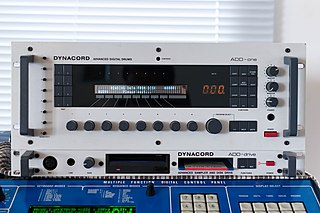 W
WThe Dynacord ADD-One is a German-manufactured, American-designed drum machine that was first released in 1986. It uses recorded samples to produce its sounds through analog voltage controlled envelopes and analog filters with resonance, to self-oscillation per voice. It comes with 1Mbyte of memory and can be upgraded up to 8Mbytes.
 W
WThe Fairlight CMI is a digital synthesizer, sampler, and digital audio workstation introduced in 1979 by Fairlight. It was based on a commercial licence of the Qasar M8 developed by Tony Furse of Creative Strategies in Sydney, Australia. It was one of the earliest music workstations with an embedded digital sampler, and is credited for coining the term sampling in music. It rose to prominence in the early 1980s and competed with the Synclavier from New England Digital.
 W
WFocusrite PLC is an English music and audio products group based in High Wycombe, England. The Focusrite Group trades under eight brands: Focusrite, Focusrite Pro, Martin Audio, ADAM Audio, Novation, Ampify Music, Optimal Audio and Sequential. Focusrite designs and markets audio interfaces, microphone preamps, consoles, analogue EQs and Channel strips, and digital audio processing hardware and software for professional and home studios.
 W
WIamus is a computer cluster located at Universidad de Málaga. Powered by Melomics' technology, the composing module of Iamus takes 8 minutes to create a full composition in different musical formats, although the native representation can be obtained by the whole system in less than a second. Iamus only composes full pieces of contemporary classical music.
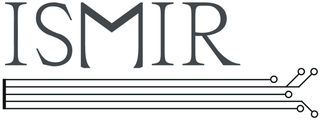 W
WThe International Society for Music Information Retrieval (ISMIR) is an international forum for research on the organization of music-related data. It started as an informal group steered by an ad hoc committee in 2000 which established a yearly symposium - whence "ISMIR", which meant International Symposium on Music Information Retrieval. It was turned into a conference in 2002 while retaining the acronym. ISMIR was incorporated in Canada on July 4, 2008.
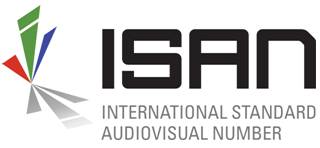 W
WInternational Standard Audiovisual Number (ISAN) is a unique identifier for audiovisual works and related versions, similar to ISBN for books. It was developed within an ISO TC46/SC9 working group. ISAN is managed and run by ISAN-IA.
 W
WA loudspeaker is an electroacoustic transducer, that is, a device that converts an electrical audio signal into a corresponding sound. A speaker system, also often simply referred to as a "speaker" or "loudspeaker", comprises one or more such speaker drivers, an enclosure, and electrical connections possibly including a crossover network. The speaker driver can be viewed as a linear motor attached to a diaphragm which couples that motor's movement to motion of air, that is, sound. An audio signal, typically from a microphone, recording, or radio broadcast, is amplified electronically to a power level capable of driving that motor in order to reproduce the sound corresponding to the original unamplified electronic signal. This is thus the opposite function to the microphone, and indeed the dynamic speaker driver, by far the most common type, is a linear motor in the same basic configuration as the dynamic microphone which uses such a motor in reverse, as a generator
 W
WMelomics is a computational system for the automatic composition of music, based on bioinspired algorithms.
 W
WMelomics109 is a computer cluster located at Universidad de Málaga. It is part of the Spanish Supercomputing Network, and has been designed to increase the computational power provided by Iamus. Powered by Melomics' technology, the composing module of Melomics109 is able to create and synthesize music in a variety of musical styles. This music has been made freely accessible to everyone.
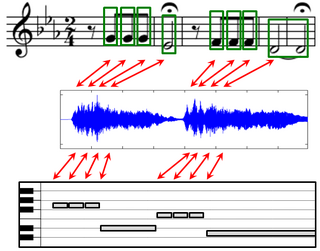 W
WMusic can be described and represented in many different ways including sheet music, symbolic representations, and audio recordings. For each of these representations, there may exist different versions that correspond to the same musical work. The general goal of music alignment is to automatically link the various data streams, thus interrelating the multiple information sets related to a given musical work. More precisely, music alignment is taken to mean a procedure which, for a given position in one representation of a piece of music, determines the corresponding position within another representation. In the figure on the right, such an alignment is visualized by the red bidirectional arrows. Such synchronization results form the basis for novel interfaces that allow users to access, search, and browse musical content in a convenient way.
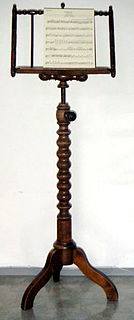 W
WA music stand is a pedestal or elevated rack designed to hold a paper score or sheets of music in position for reading. Most music stands for orchestral, chamber music or solo orchestra-family instruments can be raised or lowered to accommodate seated or standing performers, or performers of different heights. Many types of keyboard instruments have a built-in or removable music rack or stand where sheet music can be placed. Music stands enable musicians to read sheet music or scores while playing an instrument or conducting, as the stand leaves the hands free. Music stands are sometimes used by singers, however for choirs, singers typically hold their sheet music in a folder, and singers performing solo recitals or opera performances typically memorize the lyrics and melodies. Some singers use stands, such as lounge singers and wedding vocalists who have a repertoire of hundreds of songs, which makes remembering all of the verses difficult.
 W
WA music store or musical instrument store is a retail business that sells musical instruments and related equipment and accessories. Some music stores provide additional services for a fee, such as music lessons, instrument or equipment rental, or repair services.
 W
WElectric music technology refers to musical instruments and recording devices that use electrical circuits, which are often combined with mechanical technologies. Examples of electric musical instruments include the electro-mechanical electric piano, the electric guitar, the electro-mechanical Hammond organ and the electric bass. All of these electric instruments do not produce a sound that is audible by the performer or audience in a performance setting unless they are connected to instrument amplifiers and loudspeaker cabinets, which made them sound loud enough for performers and the audience to hear. Amplifiers and loudspeakers are separate from the instrument in the case of the electric guitar, electric bass and some electric organs and most electric pianos. Some electric organs and electric pianos include the amplifier and speaker cabinet within the main housing for the instrument.
 W
WA musical fountain, also known as a dancing fountain, is a type of animated fountain for entertainment purposes that creates an aesthetic design. This is achieved by employing the effects of timed sound waves and timed light against water particles. The water refracts and reflects the light, and in doing so, three-dimensional images can be produced.
 W
WNew Interfaces for Musical Expression, also known as NIME, is an international conference dedicated to scientific research on the development of new technologies and their role in musical expression and artistic performance.
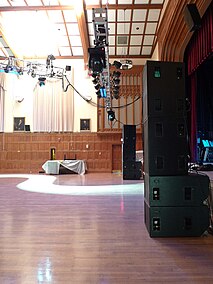 W
WA professional audio store is a retail business that sells, and in many cases rents, sound reinforcement system equipment and PA system components used in music concerts, live shows, dance parties and speaking events. This equipment typically includes microphones, power amplifiers, electronic effects units, speaker enclosures, monitor speakers, subwoofers and audio consoles (mixers). Some professional audio stores also sell sound recording equipment, DJ equipment, lighting equipment used in nightclubs and concerts and video equipment used in events, such as video projectors and screens. Some professional audio stores rent "backline" equipment used in rock and pop shows, such as stage pianos and bass amplifiers. While professional audio stores typically focus on selling new merchandise, some stores also sell used equipment, which is often the equipment that the company has previously rented out for shows and events.
 W
WSound Credit is a music credits platform with computer software applications for Windows, macOS, iOS, and Android. It includes the Sound Credit Publisher cross-platform desktop application, the Tracker cross-platform digital audio workstation (DAW) plug-in, physical kiosks, smart card check-in system, and online database.
 W
WStereophonic sound or, more commonly, stereo, is a method of sound reproduction that recreates a multi-directional, 3-dimensional audible perspective. This is usually achieved by using two or more independent audio channels through a configuration of two or more loudspeakers in such a way as to create the impression of sound heard from various directions, as in natural hearing. Thus the term "stereophonic" applies to so-called "quadraphonic" and "surround-sound" systems as well as the more common two-channel, two-speaker systems. Stereo sound has been in common use since the 1970s in entertainment media such as broadcast radio, TV, recorded music, internet, computer audio, and cinema.